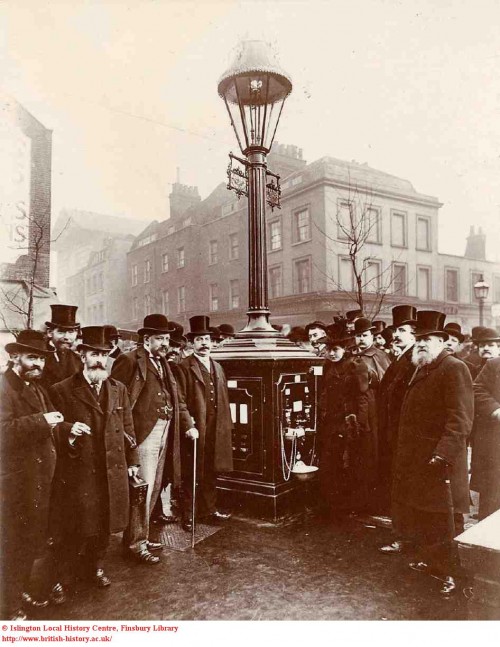We are all familiar with vending machines dispensing sugary drinks and confections at various locations around our fine city, but did you know that some of the earliest vending machines were built into the bases of gas lamps?
At the Great Exhibition of 1897, a demonstration was made of a gas lamp that also included an automatic machine that could dispense a gallon of hot water, or a halfpennies worth of Beef tea essence, Cocoa, Milk, Sugar, Tea or Coffee.
These “Pluto Lamps” were developed by a company founded in 1896 by Mr. H M Robinson variously known as either the “Hot Water Supply Syndicate” or the “Refreshment Lamp Syndicate” and they installed a number of these vending machines around the city before seemingly vanishing with barely a memory of their existence.
A few newspaper records exist, such as a report in the Pall Mall Gazette of the 8th July 1898 commenting on the opening of the first Pluto Lamp, within Leicester Square.
That lamp is described as being filled with Welshbach mantles on a Denayrouze burner and able to draw of quarts of water in quick succession. From other slots could be obtained hot coffee, coca and fluid beef via enamel vessels secured to the gas lamp by a chain.
What was also described as “another great boon” was the availability of cigarettes at four to the penny and even postcards were offered.
The Pluto Lamps must have been modestly successful as the following year, the Morning Post of 8th Feb 1899 noting that a Pluto Lamp was to be installed on a plot of land in Rosebery Avenue which had been recently sold to the Clerkenwell Vestry.
In addition to dispensing hot drinks, and obviously providing a valuable service in providing illumination to the dark streets – the Clerkenwell model also included one of Steljes ABC Telegraph Recorders which was connected to Scotland Yard for the police to use.
Remarkably though, there is a very early photograph of it on the day it was installed – and is probably the “most Victorian” photo you will ever see.
However, it was apparently not a success and was removed by October in the same year. It is possible that part of the reason was that locals found they could supplement half-penny coins with small round pieces of tin. Opened in February, by April over 1,000 pieces of tin had been found inside the vending machine, according to a report into the arrest of one such thief in the Daily Mail of April 6th 1899.
The “urchin” was bound over for six months. Substituting coins for base metals has been a problem for street vending machines ever since.








Class – I remember a sign at school on the drinks machine that said, “Any coins found in this machine with foil on them, will lead to this machine being removed!” As hard-up schoolboys made 10p’s into 50p’s!
Good to see that they were simply keeping up tradition.